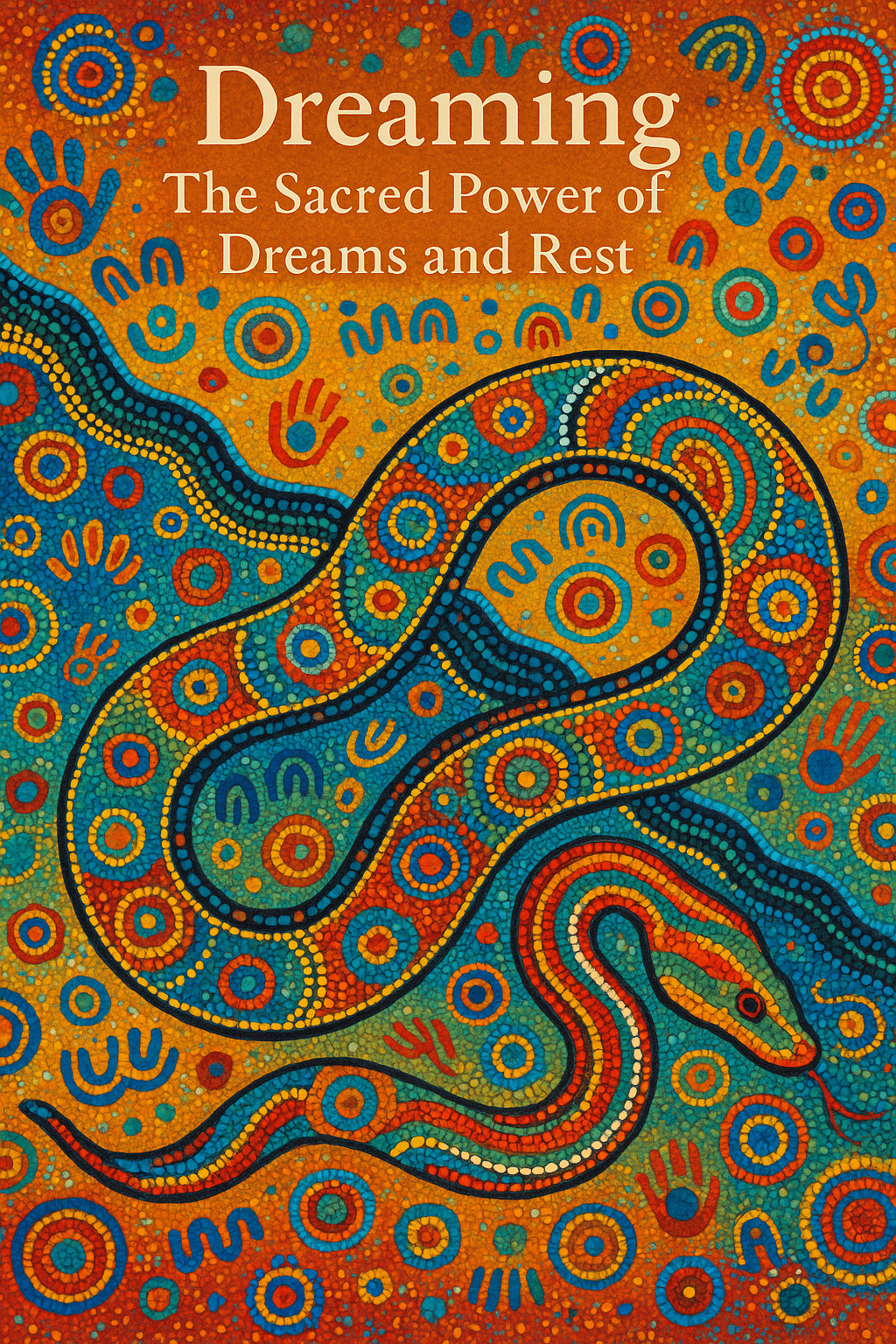“There is a place beyond time, where the land dreams – and we are dreamed in return.”
Dreams have always fascinated us. They carry us to places that are at once familiar and strange. In those moments, we process tangled emotions, stumble upon flashes of insight and sometimes receive messages that feel as if they’ve come from somewhere far beyond our everyday understanding.
From the ancient world right through to modern psychology, dreams have been viewed as a link – a bridge between our daily life and something much deeper. They can be mystical, wild, unsettling and comforting… but always alive with meaning.
For the Aboriginal peoples of Australia, Dreamtime (Tjukurpa) sits at the very heart of life. It isn’t simply a myth or an old legend, nor is it only a dream. It’s a living reality – a sacred truth – where the spiritual and physical worlds touch. Dreamtime holds the stories of the Ancestors, the great Beings who shaped the rivers, mountains, plains and every living thing. Through these stories, the people are guided into harmony with the land, with each other and with the moral and spiritual compass of their community.
Songlines and Ley-lines
In Aboriginal tradition, the land is far more than solid ground beneath our feet. It holds a living map of sacred pathways known as Songlines. These invisible trails follow the journeys of the Ancestors, carrying the songs, laws and wisdom of the Dreaming. Elders say each Songline is alive with story, memory and truth – passed down through countless generations.
One tale tells of Mirrin and the Sky River – a boy who, by following the Milky Way’s reflection along the sand dunes, traced the path of a great Serpent. Guided by dreams and instinct, Mirrin uncovered a hidden spring deep beneath the earth, bringing water back to his people. It is a story that reflects the Aboriginal knowing: the land itself holds wisdom and by walking the Songlines with respect, one can find the guidance needed for both survival and spirit.
To follow a Songline is to remember. To listen. To be still enough to feel the earth’s quiet song. And here lies a deeper truth: dreaming is not just for the hours of sleep – it can also be a way of moving through the world, awake yet open to its unseen layers.
In Western traditions, a similar idea exists in the form of Ley-lines – energetic pathways said to run across the earth, linking sacred sites. Many believe ancient builders, including those of Stonehenge, sensed these lines and placed their monuments in harmony with them. Walking these paths, some say, can sharpen awareness and deepen connection to the land.
The early 20th-century book The Old Straight Track by Alfred Watkins explored this very idea – that ancient people used straight alignments for navigation, ceremony and trade, and that these lines formed a kind of energetic web across the land. More recently, Hamish Miller and Paul Broadhurst traced the Michael and Mary lines across southern Britain, a winding path of power running through Glastonbury, Avebury, and St. Michael’s Mount. Their work seems to echo the oldest voices of the earth: the land is alive – and we are part of its dreaming.
Dreams as a bridge between worlds
Cultures across the globe have long held dreams as a threshold – a crossing point between the physical and the spiritual.
In Ancient Egypt, dreams were believed to be direct messages from the gods. People would sleep in special “dream temples” in the hope of receiving visions for healing or guidance. The Greeks practised Oneiromancy – dream interpretation – as a way to listen to the divine.
The Māori of New Zealand speak of dreams as pathways for ancestors to speak to the living and to ignore such dreams is to turn away from the voice of one’s own lineage. Among the Lakota people, the vision quest (Hanbleceya) invites deep solitude and rest in nature so that dreams and visions may rise, offering direction for one’s life journey.
From Inuit shamans interpreting messages from the spirit world, to Celtic druids seeking prophecy through Imbas Forosnai – a trance-like dream state – there is a shared thread: dreams are teachers, healers and storytellers.
Scientific Insights: The Dreaming Brain
Modern science is only now catching up with what ancient cultures already understood. Carl Jung spoke of a “collective unconscious” – a shared reservoir of symbols that surface in dreams across humanity.
Today, researchers know that dreaming is an active, vital process for both mind and body. During REM sleep, for example, the brain works to integrate our waking experiences, strengthening neural pathways and softening the emotional charge around difficult events. This is also the time when creative connections often spark; the kind that arrive as flashes of inspiration on waking.
In deep sleep, the glymphatic system goes to work, flushing toxins from the brain and supporting renewal at a physical level. And for those who practise lucid dreaming, there can be even greater rewards: enhanced problem-solving, heightened creativity and a stronger sense of emotional resilience.
Inviting Dreamtime into rest
You don’t have to be asleep to touch the wisdom of Dreamtime. Finding a quiet place in nature – a bench in a park, a patch of woodland or a garden corner can invite the same stillness. Let yourself notice the details: the movement of leaves, the way the wind changes, the scent of the earth. Let yourself zone out.
Sometimes wisdom comes not through searching for answers, but by letting the quiet open a space where answers can find you.
At night, you might create a small ritual before bed. A candle, a few deep breaths and an open intention can invite dreams to speak. Keeping a notebook or journal close at hand allows you to catch the messages before they fade away in the morning.
In this way, rest becomes more than physical recovery. It becomes a return – a homecoming to something ancient in the soul.
How to remember your dreams
If you wish to remember your dreams more vividly, it can help to treat them as honoured guests. Welcome them by writing down even the smallest fragments as soon as you wake, before they dissolve. You might set an intention before sleep, asking for guidance on something close to your heart, or simply invite clarity to come.
Your sleeping environment also matters. Dimmed lights, quiet surroundings, and time away from screens signal to the body that it’s safe to drift deeply. Some people find that practising gentle awareness during the day – looking around and asking, “Am I dreaming?” can help train the mind to recognise and become conscious within dreams.
A few minutes of meditation before bed can make dreams more vivid, while staying still upon waking can help hold onto them. Lying quietly with your eyes closed, replay the dream in your mind before it slips away. Over time, these small practices open the doorway to a richer dream life.
Story: Maru, the Dreaming Serpent
Long ago, when the stars still sang to the land, there was a great water serpent called Maru. He coiled deep underground, winding through hidden rivers, keeping the waters moving and the land in balance.
Maru understood the art of rest. He moved only when needed. When he lay still, the earth softened, waters settled and life thrived.
But one year the rains failed. The sun scorched the ground. People dug and searched, restless and desperate – yet the harder they pushed, the drier the land became. They did not pause to listen to the heartbeat of the earth or to hear Maru’s song.
One night, an elder slept beneath a gum tree and dreamed. In the dream, Maru appeared, his scales shimmering with light and water. He showed her rivers flowing beneath the surface, waiting. He whispered: move with the land, not against it.
When she woke, she told the people. A few listened. They slowed. They rested. That night they dreamed together, and in the morning, the ground split open – a surge of cool water spilling into the dry riverbed.
From then on, they knew dreams were not illusions but messages – truths woven into the land, waiting for ears and hearts willing to hear.

